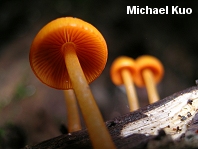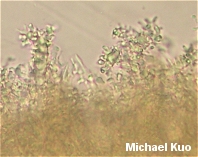| Major Groups > Gilled Mushrooms > Pale-Spored > Mycenoid Mushrooms |

|
Mycenoid Mushrooms [ Basidiomycetes > Agaricales > Tricholomataceae . . . ] by Michael Kuo Some of the most beautiful and elegant mushrooms on earth, in my opinion, are included among the "mycenoid" species--those that used to belong in the Friesian genus "Mycena." Most of the species are extremely small mushrooms, rarely exceeding a few centimeters in diameter and often only reaching diameters of a few millimeters. They are frequently overlooked, unless they happen to be growing in large clusters. But for those who are willing to slow down and appreciate the beauty of small things, they can be quite stunning. The tell-tale characteristics of this group include a white spore print, a small conical or bell-shaped cap, and a thin stem that is not tough or wiry. A few species, like Mycena leaiana, are brightly colored, but many are gray, brown, or whitish. Alexander Smith's 1947 monograph of Mycena (online here) contains 232 North American species, and the number of mycenoid species has only increased since. Many North American mycenoid mushrooms are currently going under European names--a situation that is likely to change when someone's dissertation involves a DNA study of North American and European collections. For the time being, however, we are left with a sixty-year-old treatment and a lot of species requiring microscopic observation for successful identification. Careful observation of what it is, exactly, that these little saprobes are decomposing is crucial to successful identification of mycenoid mushrooms. Many species grow in clusters on decaying stumps and logs, while others arise from debris on the forest floor or from the bark of living (or recently dead) trees. A few play very specialized ecological roles; Mycena luteopallens, for example, arises from the nut shells and nuts of hickories and walnuts. You will often need a fairly large collection of mycenoid mushrooms to work with in order to adequately assess many of the features that are crucial to identification. Odor is often very important, and is best determined by taking a complete cap and squeezing it into mush between your thumb and forefinger, then taking a whiff. Distinctive odors in the group include bleachlike, radishlike, iodinelike, and mealy smells. Physical features frequently used for identification of mycenoid mushrooms include colors of the cap, stem, and gills; the manner in which the gills are attached to the stem; whether the edges of the gills are the same color as the faces; whether the fresh stem exudes a juice when squeezed or sliced; whether the stem surface is sticky or not; the shape of the cap; and details regarding the base of the stem. Many of these features, however, are somewhat variable, and can change between button stage and maturity--another reason a large collection, representing all stages of development, is often necessary. Microscopic features are usually crucial for identification. Most of the important microscopic details (basidia, cheilocystidia, pleurocystidia, and pileipellis) can be observed with a successful Roman aqueduct section mounted in 2% KOH with a phloxine stain. Spore observations should be made in a Melzer's reagent mount to assess whether the spores are amyloid or not. While most mycenoid species have amyloid spores, they are not as strikingly amyloid as, for example, the amyloid spores of some Amanita species--and the amyloidity usually fades as the spores age and mature, so that many spores in a mount are inamyloid. Some mycenoid mushrooms, however, have truly inamyloid spores (these are often yellowish in Melzer's), so careful assessment is required. DNA studies that have included mycenoid specimens have made it fairly clear that what we are now calling the genus "Mycena" represents a pretty incoherent group of genetic entities, and we will eventually wind up with several genera and a much smaller genus Mycena, centered around the type species of Mycena, Mycena galericulata. Believe it or not, Panellus stipticus is apparently more closely related to some of the mushrooms we currently place in "Mycena" than many of the other species we assume to belong in the same genus! Other mycenoid (or sometimes-mycenoid) genera include Hemimycena, Hydropus, Roridomyces, Rickenella, and several others. |
© MushroomExpert.Com |






